java實現圖形化界面計算器
本文實例為大家分享了java實現圖形化界面計算器的具體代碼,供大家參考,具體內容如下
最終效果圖:
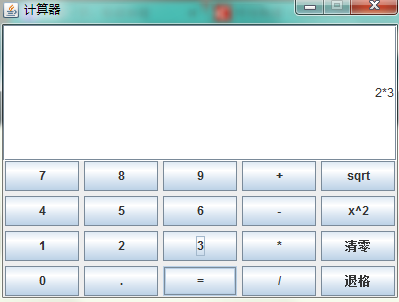
項目流程:
第一步:實現圖形化界面(添加計算器的 Button 和 用于顯示輸入數字、輸出結果的JTextField等)
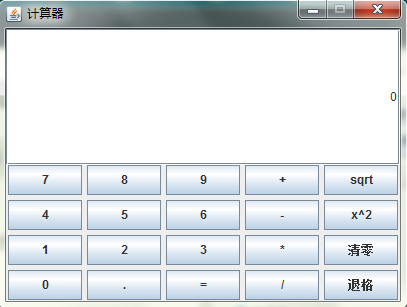
第二步:給按鈕和文本框添加鼠標監聽事件。
第三步:實現加減乘除、開方、平方、清零和退格功能。
開方運算:
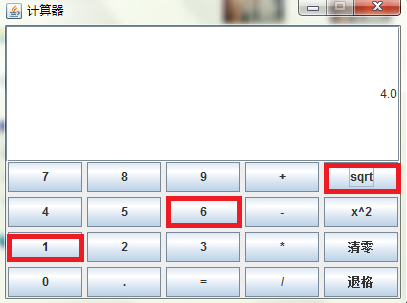
平方運算:

加法運算:
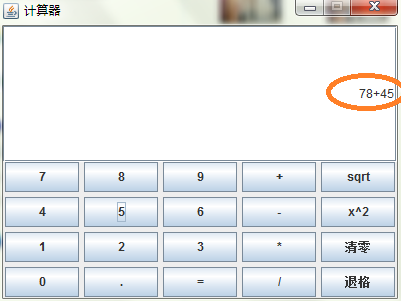
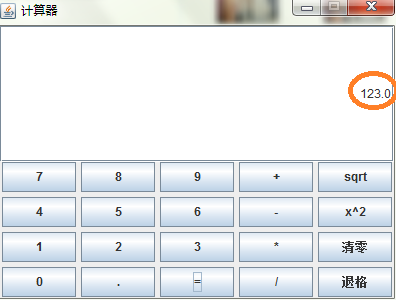
減法運算:
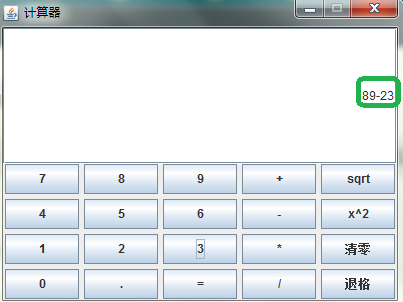
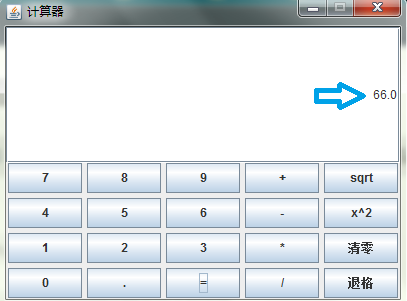
乘法運算:
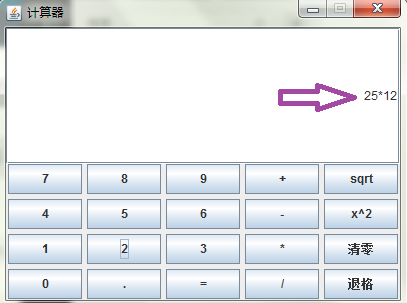
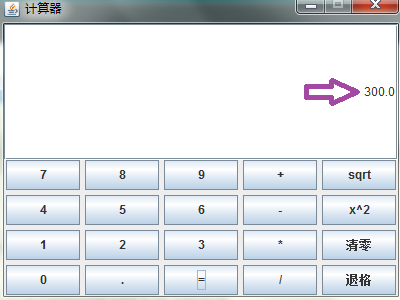
除法運算:
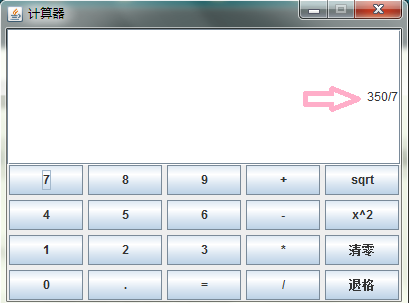
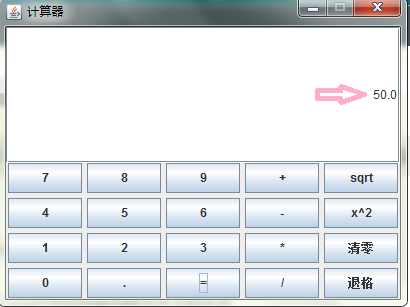
完整項目代碼:
package First_App;import java.awt.*;import java.awt.event.*;import javax.swing.*;public class Caculator extends JFrame{ /* * 圖形化界面設計 * */ private static final long serialVersionUID = 4907149509182425824L; public Caculator(){ Container c = getContentPane(); //定義一個頂級容器c setLayout(new GridLayout(2,1));//新建網格布局管理器,2行1列 JTextField jtf = new JTextField('0',40);//構造一個用指定文本和列初始化的新文本框--jtf jtf.setHorizontalAlignment(JTextField.RIGHT);//設置水平對齊方式:居右對齊 JButton data0 = new JButton('0'); JButton data1 = new JButton('1'); JButton data2 = new JButton('2'); JButton data3 = new JButton('3'); JButton data4 = new JButton('4'); JButton data5 = new JButton('5'); JButton data6 = new JButton('6'); JButton data7 = new JButton('7'); JButton data8 = new JButton('8'); JButton data9 = new JButton('9'); JButton point = new JButton('.'); JButton equ = new JButton('='); JButton plus = new JButton('+'); JButton minus = new JButton('-'); JButton mtp = new JButton('*'); JButton dvd = new JButton('/'); JButton sqr = new JButton('sqrt'); JButton root = new JButton('x^2'); JButton tg = new JButton('退格'); JButton ql = new JButton('清零'); JPanel jp = new JPanel(); //新建JPanel面板--jp jp.setLayout(new GridLayout(4,5,5,5));//新建網格布局管理器(行數,列數,組件間的水平垂直間距) jp.add(data7); jp.add(data8); jp.add(data9); jp.add(plus); jp.add(sqr); jp.add(data4); jp.add(data5); jp.add(data6); jp.add(minus); jp.add(root); jp.add(data1); jp.add(data2); jp.add(data3); jp.add(mtp); jp.add(ql); jp.add(data0); jp.add(point); jp.add(equ); jp.add(dvd); jp.add(tg); c.add(jtf);//將文本框jtf添加到頂級容器c中 c.add(jp);//將JPanel面板jp添加到頂級容器c中 setSize(400,300); setTitle('計算器'); setVisible(true); setResizable(false);//窗體大小由程序員決定,用戶不能自由改變大小 setDefaultCloseOperation(WindowConstants.EXIT_ON_CLOSE); /* * ********************************************************* * 相關計算功能的實現 * ********************************************************* * */ data0.addActionListener(new ActionListener(){//數字0的輸入 public void actionPerformed(ActionEvent arg0){ if(jtf.getText().equals('0')){//將按鈕值與0作比較 jtf.requestFocus();//把輸入焦點放在調用這個方法的控件上(即把光標放在文本框jtf里) } else{ String str = jtf.getText();//取得當前按鈕的按鈕值 jtf.setText(str+'0'); //將文本內容后加上字符0 } } }); data1.addActionListener(new ActionListener(){//數字1的輸入 public void actionPerformed(ActionEvent arg0){ if(jtf.getText().equals('0')){//將按鈕值與0作比較 jtf.setText('');//將文本框初始化為空 jtf.setText('1');//將文本框內容置為 1 jtf.requestFocus();//把輸入焦點放在調用這個方法的控件上(即把光標放在文本框jtf里) } else{ String str = jtf.getText();//取得當前按鈕的按鈕值 jtf.setText(str+'1'); //將文本內容后加上字符1 } } }); data2.addActionListener(new ActionListener(){ public void actionPerformed(ActionEvent arg0){ if(jtf.getText().equals('0')){ jtf.setText(''); jtf.setText('2'); jtf.requestFocus(); } else{ String str = jtf.getText(); jtf.setText(str+'2'); } } }); data3.addActionListener(new ActionListener(){ public void actionPerformed(ActionEvent arg0){ if(jtf.getText().equals('0')){ jtf.setText(''); jtf.setText('3'); jtf.requestFocus(); } else{ String str = jtf.getText(); jtf.setText(str+'3'); } } }); data4.addActionListener(new ActionListener(){ public void actionPerformed(ActionEvent arg0){ if(jtf.getText().equals('0')){ jtf.setText(''); jtf.setText('4'); jtf.requestFocus(); } else{ String str = jtf.getText(); jtf.setText(str+'4'); } } }); data5.addActionListener(new ActionListener(){ public void actionPerformed(ActionEvent arg0){ if(jtf.getText().equals('0')){ jtf.setText(''); jtf.setText('5'); jtf.requestFocus(); } else{ String str = jtf.getText(); jtf.setText(str+'5'); } } }); data6.addActionListener(new ActionListener(){ public void actionPerformed(ActionEvent arg0){ if(jtf.getText().equals('0')){ jtf.setText(''); jtf.setText('6'); jtf.requestFocus(); } else{ String str = jtf.getText(); jtf.setText(str+'6'); } } }); data7.addActionListener(new ActionListener(){ public void actionPerformed(ActionEvent arg0){ if(jtf.getText().equals('0')){ jtf.setText(''); jtf.setText('7'); jtf.requestFocus(); } else{ String str = jtf.getText(); jtf.setText(str+'7'); } } }); data8.addActionListener(new ActionListener(){ public void actionPerformed(ActionEvent arg0){ if(jtf.getText().equals('0')){ jtf.setText(''); jtf.setText('8'); jtf.requestFocus(); } else{ String str = jtf.getText(); jtf.setText(str+'8'); } } }); data9.addActionListener(new ActionListener(){ public void actionPerformed(ActionEvent arg0){ if(jtf.getText().equals('0')){ jtf.setText(''); jtf.setText('9'); jtf.requestFocus(); } else{ String str = jtf.getText(); jtf.setText(str+'9'); } } }); point.addActionListener(new ActionListener(){ //點號的輸入 public void actionPerformed(ActionEvent arg0){ if(jtf.getText().equals('0')){ jtf.setText(''); jtf.setText('.'); jtf.requestFocus(); } else{ String str = jtf.getText(); jtf.setText(str+'.'); } } }); plus.addActionListener(new ActionListener(){ //+號的輸入 public void actionPerformed(ActionEvent arg0){ if(jtf.getText().equals('0')){ jtf.setText(''); jtf.setText('+'); jtf.requestFocus(); } else{ String str = jtf.getText(); jtf.setText(str+'+'); } } }); minus.addActionListener(new ActionListener(){ //-號的輸入 public void actionPerformed(ActionEvent arg0){ if(jtf.getText().equals('0')){ jtf.setText(''); jtf.setText('-'); jtf.requestFocus(); } else{ String str = jtf.getText(); jtf.setText(str+'-'); } } }); mtp.addActionListener(new ActionListener(){ //*號的輸入 public void actionPerformed(ActionEvent arg0){ if(jtf.getText().equals('0')){ jtf.setText(''); jtf.setText('*'); jtf.requestFocus(); } else{ String str = jtf.getText(); jtf.setText(str+'*'); } } }); dvd.addActionListener(new ActionListener(){ //除號的輸入 public void actionPerformed(ActionEvent arg0){ if(jtf.getText().equals('0')){ jtf.setText(''); jtf.setText('/'); jtf.requestFocus(); } else{ String str = jtf.getText(); jtf.setText(str+'/'); } } }); //【**退格功能如下**】 tg.addActionListener(new ActionListener(){//監聽退格鍵 public void actionPerformed(ActionEvent arg0){//處理退格鍵被按下的事件 String text = jtf.getText(); int i = text.length(); if(i>0){ text = text.substring(0,i-1);//去掉最后一個字符 if (text.length() == 0) {// 如果文本沒有了內容,則初始化計算器的各種值 jtf.setText('0'); } else { // 顯示新的文本 jtf.setText(text); } } } }); //【**清零功能如下**】 ql.addActionListener(new ActionListener(){//監聽清零鍵 public void actionPerformed(ActionEvent e) { jtf.setText('0');//將文本框置為0(清零功能) } }); //【**平方功能如下**】 root.addActionListener(new ActionListener(){//監聽root鍵 public void actionPerformed(ActionEvent e){//root鍵被按事件 String i = jtf.getText(); Double j = Double.parseDouble(i);//將字符串i轉換成對應的double類型的數值 double ans = j*j; //求平方 String answer =String.valueOf(ans);//將int型數據轉換成String類型 jtf.setText(answer);//將文本框設置為平方后的結果 } }); //【**開方功能如下**】 sqr.addActionListener(new ActionListener(){//監聽sqrt鍵 public void actionPerformed(ActionEvent e){//sqrt鍵被按事件 String i = jtf.getText(); Double j = Double.parseDouble(i);//將字符串轉換成對應的double類型的數值 double ans = (double)Math.sqrt(j);//求開方 String answer = String.valueOf(ans);//將double型數據轉換成String類型 jtf.setText(answer);//將文本框設置為開方后的結果 } }); //【等號實現 加減乘除 功能】 equ.addActionListener(new ActionListener(){ //監聽 “等號” 按鍵 public void actionPerformed(ActionEvent arg0){//處理“等號” 按鍵被按下事件 //【**加法運算**】 if(jtf.getText().indexOf('+')!= -1){ //將字符串分割為子字符串,然后將結果作為字符串數組返回 String[] s = jtf.getText().split('[+]');//轉義字符,要用'[+]'或者'+' Double d1 = Double.parseDouble(s[0]);//返回一個指定字符串表示的double值 Double d2 = Double.parseDouble(s[1]); double ans = d1 + d2; String answer = String.valueOf(ans);//將結果轉換為字符串 jtf.setText(answer);//將加法運算的結果以字符串形式在文本框中顯示 } //【**減法運算**】 else if(jtf.getText().indexOf('-')!= -1){ String[] s = jtf.getText().split('-'); jtf.setText(''); Double d1 = Double.parseDouble(s[0]); Double d2 = Double.parseDouble(s[1]); double ans = d1-d2; String answer =String.valueOf(ans); jtf.setText(answer); } //【**乘法運算**】 else if(jtf.getText().indexOf('*')!= -1){ String[] s = jtf.getText().split('[*]');//*是轉義字符,要用'[*]',或者'*' jtf.setText(''); Double d1 = Double.parseDouble(s[0]); Double d2 = Double.parseDouble(s[1]); double ans = d1*d2; String answer =String.valueOf(ans); jtf.setText(answer); } //【**除法運算**】 else if(jtf.getText().indexOf('/')!= -1){ String[] s = jtf.getText().split('/'); jtf.setText(''); Double d1 = Double.parseDouble(s[0]); Double d2 = Double.parseDouble(s[1]); double ans = d1/d2; String answer =String.valueOf(ans); jtf.setText(answer); } else{ jtf.setText('請選擇要進行的運算'); } } }); } public static void main(String[] args) { new Caculator(); }}
總結:
1.掌握基本的GUI添加按鈕、文本框的方法 2.掌握字符串的處理,這里用到了indexOf()、split()等方法 3.注意Java中遇到的轉義字符。
以上就是本文的全部內容,希望對大家的學習有所幫助,也希望大家多多支持好吧啦網。
相關文章:

 網公網安備
網公網安備